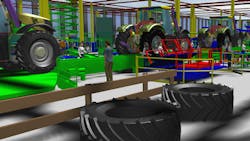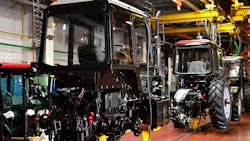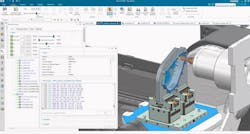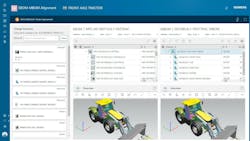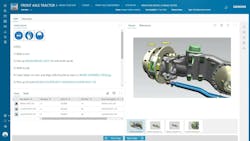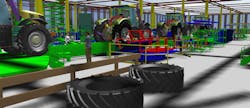Harnessing Digital Tools for Flexible and Agile Equipment Manufacturing
What you’ll learn:
- How digital tools like simulation and integrated data systems are helping OEMs respond to fluctuating demand.
- Real-world examples of how employing digital tools helped OEMs achieve measurable gains in their manufacturing operations.
- Future advancements in digital solutions and the opportunities they’ll offer product development and manufacturing.
What do we assemble where, how, and how many? These sound like easy questions, but answering them can be complex, particularly for large corporations with globally distributed activities such as heavy equipment manufacturers and their suppliers.
Therefore, many original equipment manufacturers (OEM) are turning to digital tools such as simulation to help reduce this complexity. These digital tools can help manufacturers better match demand with supply, enabling them to meet the (sometimes unique) demands of customers around the world efficiently while prioritizing quality, reliability and sustainability.
This article offers insight into the market trends creating complexity for the heavy equipment manufacturing industry, how digital tools can ease this complexity as well as real-world examples of how OEMs employed digital solutions to improve their operations.
Evolving Global Market Conditions Necessitate Agility in Manufacturing Operations
The mobile equipment industry is a cyclical business which can create challenges for the OEMs and component suppliers in this sector, as was illustrated during the 2024 downturn. For many reasons, customers like farmers and construction contractors delayed investments in new machines, leading to excess inventory.
How This Relates to the Fluid Power Industry
While much of the details in this piece center around how heavy equipment manufacturers can benefit from the use of digital tools, many of the principles are applicable to hydraulics and pneumatics companies as well. They too need to adapt their manufacturing operations to better serve evolving customer demands.
In addition, the heavy equipment industry is one of the top customer markets for the fluid power industry. Understanding the complexities OEMs in this space are facing and how they are adapting can help hydraulics and pneumatics suppliers better serve them.
Will business normalize? Obviously, yes. But with typically thin margins, OEMs do not have time on their side. They may need to make changes to their manufacturing infrastructure and processes to adjust to market conditions, but this usually requires a substantial investment with severe impact on their organization. Agility and flexibility are key to improving business resilience, especially as more sudden demand dips can be expected in the future.
In an increasingly connected world, manufacturing has become more vulnerable to global disruptions of any kind. And due to continuously shifting geopolitics, global market conditions will remain volatile.
Therefore, manufacturers in the heavy equipment industry must make sure they can shift gears quickly by building more flexibility into their operations so they can be agile about adjusting production volumes to fluctuating demand without having to make harsh decisions like closing plants.
Having that built-in flexibility will also be necessary to successfully transition to the new generation of equipment. Very soon, production complexity will surge, with almost every order being unique, and supply having to match demand one on one. Manufacturers will have to redesign their current operations to make this possible.
Digital Tools Aid the Design of Flexible Manufacturing Systems
As manufacturers look to fine tune their operations to meet evolving market conditions, there are many variables they will need to assess.
Manufacturing-related decisions can shake a company to its foundation: There is little room for mistakes. Can existing facilities, processes and workflows be upgraded, or are greenfield investments required? If yes, what would those look like and what is the best way to integrate them with existing operations?
Besides producing what, where and how many, there is also the question of “with whom?” Which suppliers and partners are better in terms of reliability, sustainability and other factors?
It is necessary to thoroughly analyze everything upfront. This is where digitalization is critical — to study the current operational performance and use simulation to model changes and run what-if scenarios. In this way, manufacturers can weigh hundreds of options before making any spending on interventions.
With simulation software, manufacturing engineering teams can model plants and even entire manufacturing systems in 3D, including all aspects like material and part flows, workstations, equipment and people. This makes it easier to design, validate and optimize infrastructural changes.
Specifically in view of flexibility, they can change the setup of their facilities for increased modularity to handle specific orders or small lot sizes more effectively. Or they can simulate production scenarios to outline routing strategies that ensure optimal use of available resources to study if processes can be automated, and to analyze costs versus benefits when considering investing in equipment.
Such simulations could go as far as virtual commissioning, helping production ramp up quickly and flawlessly. Having detailed models, engineers can anticipate and resolve issues before they occur. This could include:
- making sure assembly processes are efficient and collision-free,
- optimizing robot placement and reach,
- designing and validating robot coding and synchronizing robotic operations,
- verifying welding, gluing and spraying operations, or
- ensuring industry and corporate standards regarding safety and ergonomics are met.
Additionally, with a dedicated tool, engineers can prepare the entire setup for part manufacturing virtually, including tooling and CNC programming, all starting from part CAD data, in an integrated and associated workflow. As such, any design change is instantly propagated throughout the entire process, providing maximum flexibility.
Real-World Examples of the Benefits Digital Tools Can Provide
Digital tools not only provide the opportunity to be more agile with production setups, but they can also help connect manufacturing with product design to create an integrated approach that benefits the entire operation.
This integrated approach, available in the Siemens Xcelerator™ solutions portfolio, helped heavy equipment manufacturer Sany achieve virtually perfect first acceptance rates and thereby boost productivity. In general, manufacturers who connect design and manufacturing achieve massive cost savings by spotting manufacturability issues and opportunities earlier and are more effective in addressing change requests.
Having this capability will become even more critical in the future, as an increasing number of orders will come with unique requirements. Also, the upcoming generation of heavy equipment customers will expect a consumer-like buying experience, putting orders together online and having the ability to change those, even after placing them. To cope with such requirements, manufacturing organizations need continuous access to design information to build their plans and readjust as necessary
Another successful application of this connected approach took place at Zoomlion, also a Siemens customer. For over two decades, Zoomlion has worked with Siemens on its digitalization journey by progressively deploying Siemens Teamcenter as its data management system, connecting activities ranging from design to manufacturing, and even down to service.
After manufacturing process design was included in the deployment, Zoomlion started to see the benefits of sharing data between design and manufacturing. The team could dynamically align process data with design BOMs (bill of materials) and also flexibly respond to design change requests. This helped them reduce the average time required to prepare data for new product processes from 15 days to 5 days.
Despite these successful examples, for many OEMs their manufacturing, design and engineering departments operate in silos, using disconnected tools and processes. Communication then happens ad hoc via spec docs, drawings, spreadsheets, while continuous, dynamic interaction using shared data is missing. But if digital tools are employed, these issues can be better addressed.
Digitally Align All Manufacturing Teams
Even within manufacturing organizations, teams such as planning, execution and quality often face communication and collaboration challenges for the same reason. This is dramatic for an organization’s overall performance as it will slow everyone down and lead to mistakes, delays, and waste of energy, materials, and resources.
Companies like Masaba and CNH Industrial (CNHi) have worked with Siemens to digitally align their manufacturing teams, each in their own way.
Masaba, which manufactures large, custom mining and aggregate equipment, deployed Opcenter™ Advanced Planning and Scheduling (APS) which lead to increased manufacturing flexibility, improved on-time deliveries by 15%, optimized operations planning, and more precise communication with customers regarding delivery dates.
At CNHi, the deployment of Teamcenter Easy Plan with capabilities for process planning, electronic work instructions and line balancing reduced the company’s manufacturing engineering time by 40% and led to a standardization of work instructions as well as fully managed tooling data across four of its plants in Brazil.
In heavy equipment, with its enormous variety of product types and associated production volumes and methods, each manufacturer is unique regarding their ideal operational model as well as their requirements to digitalize tools and processes. However, in general, any company can achieve more benefits as they broaden their scope.
Top innovators are extending their digitalization efforts beyond company walls, throughout their ecosystem, to include partners and suppliers. They collaborate with them in full transparency and in real time to communicate specifications, requirements and expectations, but also to receive information on feasibility, actual pricing, and delivery status, as well as other aspects that may impact the KPIs of their organization, like quality and sustainability.
By connecting manufacturing operations management and product lifecycle management with their enterprise resource management system, OEMs can confirm commitments, readjust timelines if necessary, and reduce any risk that may be introduced by third parties. This helps them operate globally more efficiently, while delivering on brand standards.
Moreover, with end-to-end data continuity between product design, engineering, plant and process design, program and process management, manufacturing engineering and operations, and ERP, manufacturers can track all the decisions that have been made across those areas and analyze their impact on the overall process.
By combining these insights with feedback data gathered during execution, they can build know-how about their global operations, standardize on best practices, and drive continuous improvement.
How Digitalization Can Drive Process and Product Innovation
Again, every company is unique with their own offering, capabilities, business priorities and needs, defining their progress in their digitalization journey and which steps to take next.
Deploying a closed-loop manufacturing system that enables continuous feedback from execution into other areas is a prerequisite for further process and product innovation. Think of having a smart manufacturing system that leverages data analytics and automation capabilities to maintain production excellence under all conditions.
Or think of how manufacturing information is essential to enable innovative product capabilities that require connectivity between design and the product in the field. How would, for example, predictive maintenance work if changes that were made during manufacturing would not be considered?
This tight link between digitalization and innovation leaves manufacturers little choice, especially as the emergence of artificial intelligence (AI) is widening the gap between digital leaders and those who have not embraced digitalization. As data, processes and workflows will be the fuel that feeds AI agents, companies must start capturing those to prepare themselves as the technology scales.
AI will reach its true transformative power when it can drive high-level KPIs, like those for demand planning, or strategic priorities like agility, flexibility, sustainability and quality – typically areas that are impacted by many activities within a company and beyond. Manufacturers who already manage all those in a common environment with shared data and end-to-end traceability will be ideally positioned to take the lead.
As such, heavy equipment manufacturers should consider digitalization in manufacturing as necessary and urgent. As immediate benefits, they will become more flexible at addressing evolving customer demand and more agile at facing increasingly turbulent global business conditions.
But it’s also key as part of a broader innovation initiative, required to survive in a rapidly changing industry. As the tools and systems that drive manufacturing activities directly impact daily operations and business outcomes, intervening may be challenging. The best way for OEMs to be successful is to engage with a partner like Siemens that can leverage decades of industry and manufacturing expertise to outline a digitalization roadmap, fully aligned with the customers’ specific needs and strategic business goals, and a holistic view on digitalization.
This article was written and contributed by Hendrik Lange, Senior Director of the Heavy Equipment Industry at Siemens Digital Industries Software.
About the Author
Hendrik Lange
Senior Director of the Heavy Equipment Industry, Siemens Digital Industries Software
Hendrik Lange is the Senior Director of the Heavy Equipment Industry at Siemens Digital Industries Software. He has more than 25 years of experience supporting automotive, transportation, and heavy equipment customers as they seek innovation and overcome challenges.

Leaders relevant to this article:
